Our Supermicro M11SDV-8C-LN4F review shows the power of the AMD EPYC 3000 embedded platform. With the onboard AMD EPYC 3251 8 core and 16 thread CPU, the solution is highly competitive with the Intel Xeon D-1500 and Xeon D-2100 series in terms of performance and power consumption. Furthermore, if you are a vendor looking to dual source your CPU suppliers for x86 operation, the AMD EPYC 3251 is compatible which makes it perfect for those looking to diversify their supply base.
We attended the AMD EPYC embedded launch in London about a year ago. We first benchmarked the AMD EPYC 3251 a few months ago. Now we have a commercial mITX platform from Supermicro that you can buy in the channel and start working with an AMD EPYC powered server platform at a very low cost. Our Supermicro M11SDV-8C-LN4F review is going to show you the ins and outs of the platform.
Test Configuration
Here is our basic configuration for this class of CPU:
- Motherboard: Supermicro M11SDV-8C-LN4F
- CPU: AMD EPYC 3251
- RAM: 4x 16GB DDR4-2666 ECC RDIMMs
- SSD: Intel DC S3710 400GB
- SATADOM: Supermicro 32GB SATADOM
The CPU itself supports up to 512GB of RAM, in a 4x 128GB configuration. That is as much as the Intel Xeon D-2100 series platforms and more than both the Intel Xeon D-1500 and Intel Atom C3000 series embedded platforms.
We are going to have reviews down the stack over the course of the next few weeks. Practically, the Supermicro M11SDV-8C-LN4F, M11SDV-8C+-LN4F, M11SDV-8CT-LN4F, M11SDV-4C-LN4F, and M11SDV-4CT-LN4F are all very similar. The 8C+ is the same as what we are reviewing but with an active CPU cooler. The remainder of the SKU stack simply use lower cost and performance CPU models. With the Supermicro M11SDV-8CT-LN4F, only DDR4-2133 speeds are supported to ensure that 8 core model is able to maintain the lowest power consumption. This Supermicro M11SDV-8C-LN4F has both SMT and DDR4-2666 support.
You will see this test setup more in the future and it is similar to our Intel Xeon D review platform. We also spent time plugging in devices to ensure the NVMe and PCIe lanes worked as advertised. We also tried up to 128GB of RAM in 4x 32GB configurations in our testing.
Supermicro M11SDV-8C-LN4F Overview
Measuring 6.7″ x 6.7″ the Supermicro M11SDV-8C-LN4F is a compact mITX motherboard. Compared to previous generations, the Supermicro A2SDi-8C+-HLN4F offers a lot of expansion functionality in a very compact space. Supermicro includes both a 24-pin ATX and a DC input as ways to power the motherboard so you can easily choose a case with either a standard PC power supply or an external power brick. That deployment flexibility makes the platform more versatile.
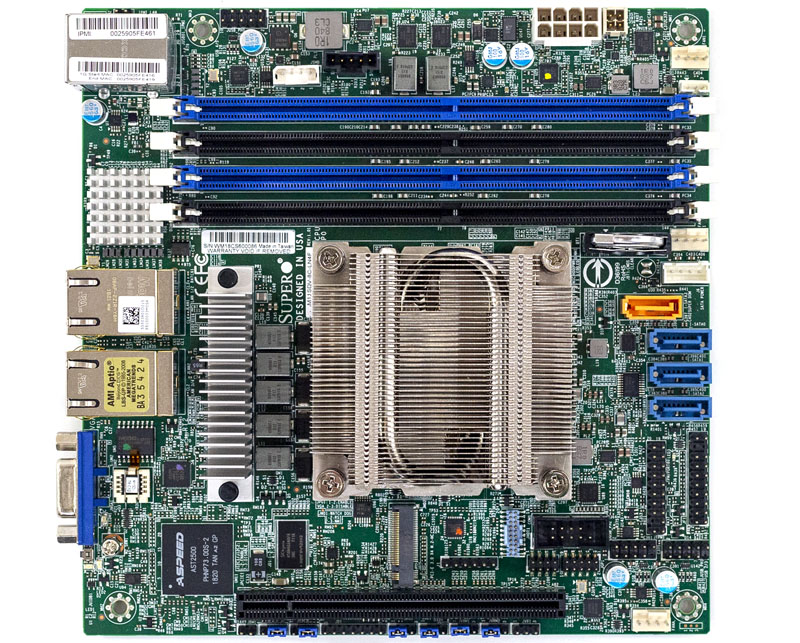
Sporting the AMD EPYC 3251 we have the first Intel Xeon D competitor from the AMD EPYC 3000 line. Here is a lscpu output:
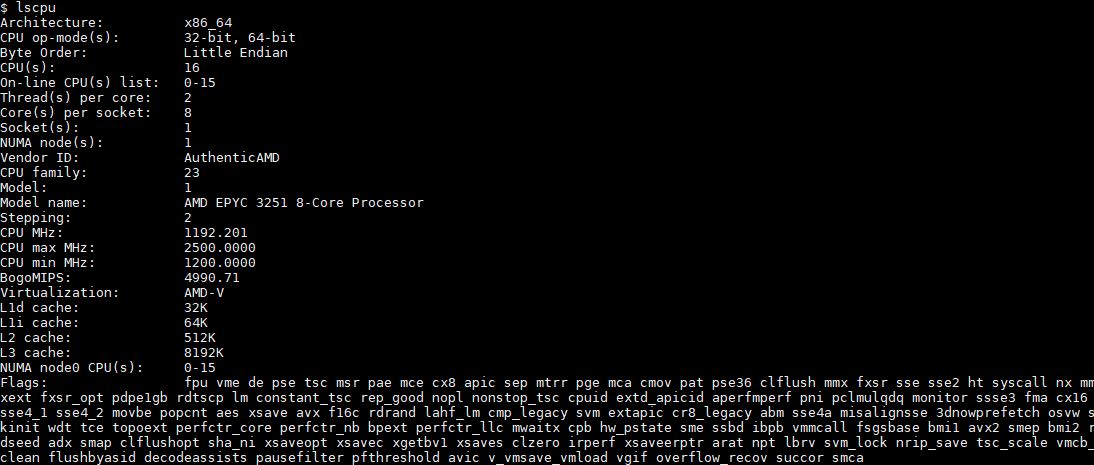
Since this class of system is expected to run computationally heavier workloads and virtualization or containers, RAM can be a priority. Here, the motherboard can support up to 4x 128GB DDR4-2666 DIMMs for a total of 512GB. We see 128GB or even 256GB as being the limit most users will want given current DRAM pricing.
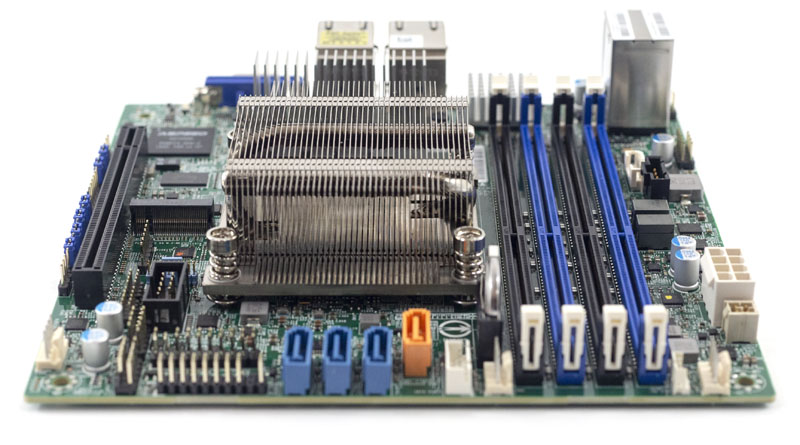
Airflow wise, all of the initial Supermicro M11SDV platforms, with the exception of the 8C+, are passively cooled. The AMD EPYC 3251 is a part that needs airflow over the heatsink. The passive heatsink design allows one to utilize redundant cooling fans on the platform.
For M.2 connectivity there is a PCIe 3.0 x4 M.2 2280 (80mm) slot for SSDs. Many SSDs with power loss protection are 110mm. We see this M.2 slot used mostly for a read cache or boot device in systems.
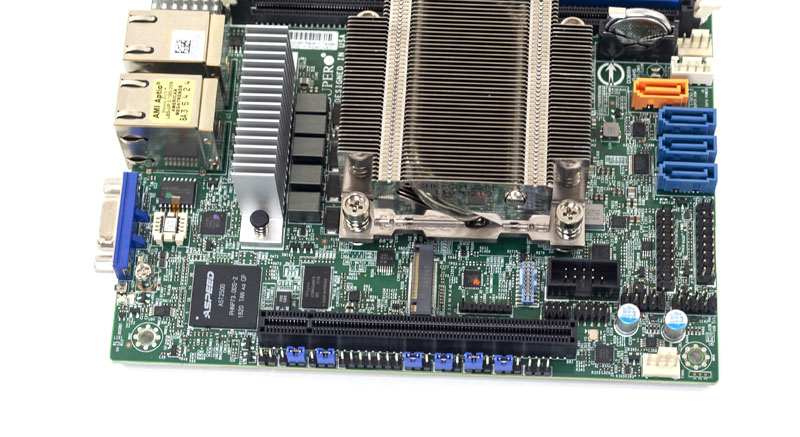
Likewise, there is SR-IOV and IOMMU support on the platform. We also wanted to note for our readers that the PCIe x16 slot is capable of running in x16, x8x8, or x4x4x4x4 mode. The 4×4 mode is useful if one, for example, wanted to use four PCIe NVMe SSDs:
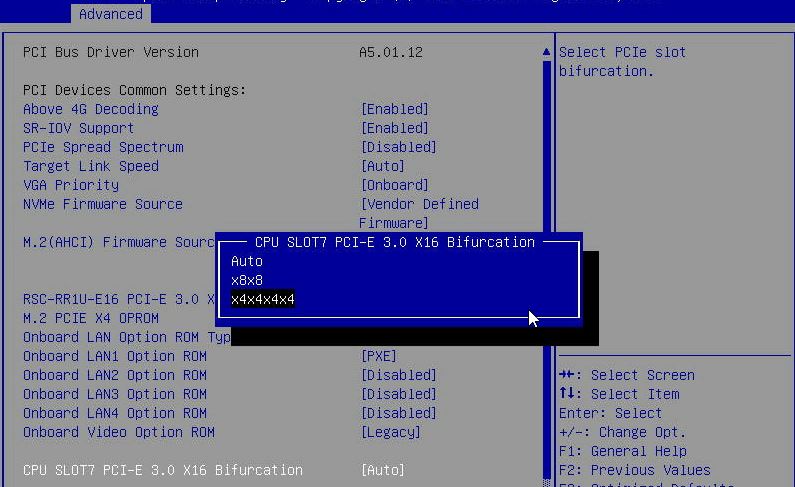
The Supermicro M11DV-8C-LN4F has a standard front panel header, COM port, and USB 2.0 headers, although no Type-A USB internal header and no USB 3.0 front panel header. From the look of the board, there does not seem to be room for those.
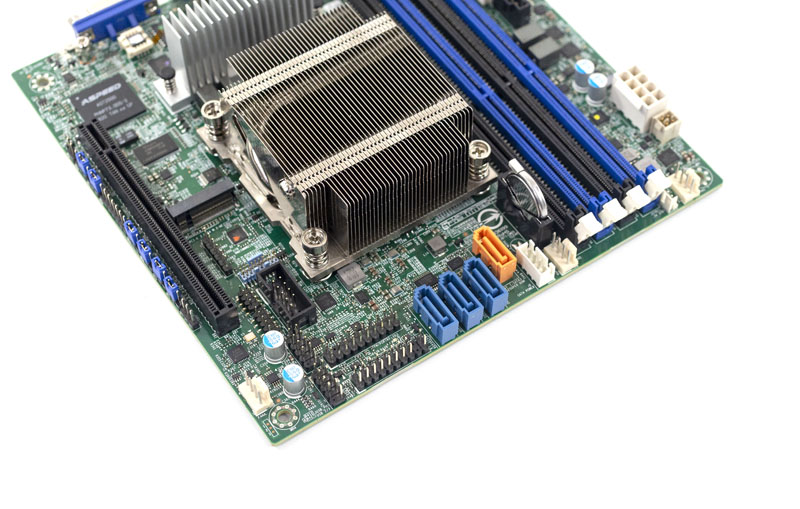
We also see four 7-pin SATA ports. One is an orange/ gold port for SATADOMs. In that port, a SATADOM does not need an additional power cable to operate which is handy in embedded applications. That white header between the SATADOM port and the battery is a power connector. When on DC power, Supermicro makes cables for that header that can power four hard drives/ SSDs. We are going to show that in the Supermicro AS-E301-9D-8CN4 system review.
The motherboard itself has three 4-pin PWM headers. That allows for a redundant SoC cooling path as well as a peripheral fan.
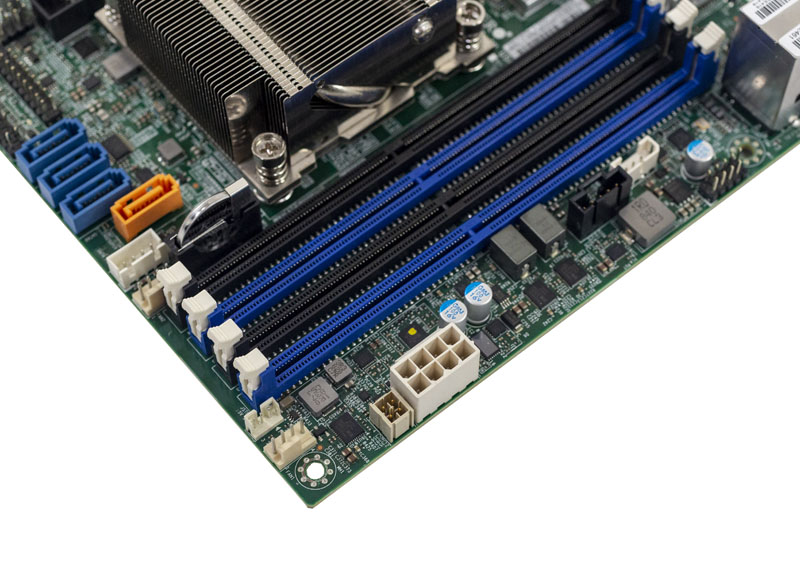
The rear I/O is comprised of a legacy VGA port on the right side and two USB 3.0 ports plus a management port on the left. Overall I/O pinout is compatible with a wide range of Supermicro embedded products so those that have systems based on Intel embedded products can likely use the same I/O shields and chassis with the Supermicro M11SDV-8C-LN4F.

Networking is provided by an Intel i350 quad port NIC. This is a 1GbE NIC that supports higher-end features like SR-IOV. At the same time, it is not leveraging the AMD EPYC 3251’s quad 10GbE NIC (as seen below from our previous piece.) While we wanted to see a 10GBE solution, we understand the conservative design decision for a first-generation embedded product. The Intel i350 is well supported by every major OS vendor. Hopefully Supermicro will release quad 10GbE versions in the future, but there is little room for 10GbE cages on the mITX motherboard so space is a constraint as well.

Next, were are going to look at the Supermicro M11SDV-8C-LN4F management and system topology. We will then show performance figures along with power consumption and our final thoughts.

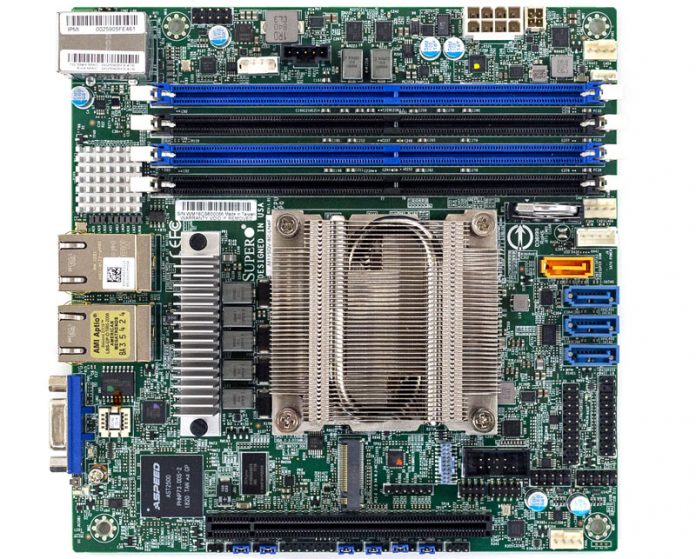



Thanks for the informative review, Patrick. This board seems rather MPD to me. Four DIMMs, four SATA, four gigE. It’s not a storage machine: needs more SATA; it’s not much of a router: needs more gigE; it’s not great as a VM host: 128GB DIMMs are frightfully expensive. And any of these applications would benefit from 10gigE.
Just a guy: I would guess this board is just a beginning in a set of boards from Supermicro build around this processor series.
I would totally be in in mATX with dual NVME and 8 Sata ports. Something like this board here:
https://www.supermicro.com/products/motherboard/X11/X11SCH-LN4F.cfm
I’d prefer a single 10GbE SFP+ to quad GbE these days. The limited SATA isn’t concerning to me, it would be easy enough to add an HBA if one really wanted lots of disks.
This would be a good upgrade from my C2558 if it had SFP+
Is there any idea of pricing on these parts? I’m checking our typical SuperMicro supplier here and these parts aren’t even listed yet.
@Bob these parts seem to have the same naming scheme as their Xeon D counterparts, so I would expect a TP4F suffix to have 10Gbit on board as well as (hopefully) some F variants for lower budget embedded appliances. The CPU performance/Watt is perfectly aligned with our edge caching use cases, so I’m eagerly awaiting parts and variants to be available.
https://www.supermicro.com/Aplus/motherboard/Embedded/EPYC3000/
Weirdly they all say they have up to 8 SATA and 10GBase-T
#David
ive just bourght a M11SDV-8C+LN4F from poland and awaiting its arival. I gave 440 euro + shipping for it, to denmark
#Brian
Where did you buy that M11SDV-8C+LN4F?
Hello,
Do you think that this motherboard will fit into the CSE-721TQ-250B chassis? This motherboard has the same dimensions as the supported Xeon boards, and the compact mini-tower chassis would be more useful (and quiet!).
It will, but I would suggest getting the -8C+- version as in the 721TQ you will need an active CPU cooler.
Did the RAM operate at 2666 Mhz? Page 16 of the manual (https://www.supermicro.com/manuals/motherboard/EPYC3000/MNL-2172.pdf) states “When the motherboard is fully populated with 4 modules of single rank DDR4 RDIMM, the memory will operate at speed of 2133MHz”. It gives other cases where RAM speed is diminished, to the point where I’m not sure what configuration of ECC DIMMs should be used to get full 2666 MHz memory speed when using all 4 DIMM slots.
Any ideas?
Alex, we always do performance testing at full speed RAM.
Patrick, yes I saw you used 2666 MHz DIMMs. My point was that the motherboard manual implies that the board can only use RAM at a maximum of 2133 MHz when all 4 DIMM slots are used (see the section I quoted in previous comment). Am I reading it wrong? Were you able to verify the RAM speed?
MNL-2172.pdf (page 16)
“When the motherboard is fully populated with 4 modules of single rank DDR4 RDIMM, the memory will operate at speed of 2133MHz.”
I’m not sure why you guys care about RAM speed so much. It’s standard that most servers, even the E5’s and big EPYC will downclock when fully populated. That’s normal. You can always manually set RAM speed. Easy. It’s working in the boards we’ve deployed and its what you’d always do if you cared about RAM speed. Some companies have their autotuning defaults to keep speed the same and give it fancy names. I don’t see what’s different with this one.
€700+ for the board.
Yikes. According o the domain name servethehome, this is hardly appropriate product.
How many homes can afford that for just a MoBo + CPU ?
For a budget solution, one might be better of with consume grade stuff, downclocked CPU and ECC compatible board…
Brane – I think many here can since they are IT professionals. Just as a FYI – over the last 10+ years STH has become the largest dedicated server review site in the world and we scale to the large multi-system servers.
Feel free to check out the history here: https://www.servethehome.com/sth-turns-10/
Patrick Kennedy:
Fine. But it still caries hefty pricetag for what it is…
Epycs are better binned than off-the-shelf stuff, I understand that.
ECC certification is wrth af few €, too since it already is working in all chips, so it is only the matter of official stamp and perhaps one testing step more during production ( if even that).
So, what is left on the board that is worth those extra €300-400 ?
For us not-exactly profeesionals it seems better to look for off-the-shelf stuff.
R7 1700 is cheap these days ( not much more than €100!) and undeclocked should churn much more than Epyc3000. On one elcheapo uATX board should work just fine.
If I opt for ECC RAM, I’d have to narrow my board choices and use unbuffered ECC, but that’s OK for my useage.
Or perhaps Asus, Asroc or Gigabyte might decide one of these days to dip their toes in these waters…
If the board does not meet your needs, and that is a realization after reading the review, then I think that is a success on our end. Our goal is to present all of the features so people can make decisions. For some, the embedded part makes a ton of sense. For others, it does not. That is the same with any platform and we just want to ensure people have access to enough information to make that decision.
Hi Patrick,
I noticed the X10SDV-TLN4F motherboard (for the XEON D-1541) has x6 SATA3 ports, but this one only has x4. What would be the recommended adapter in order to make use of additional SSDs, as the CSE-721TQ-250B chassis has space for an additional x2 drives?
This looks very interesting, however I see that vs Xeon-D this is not officially supported by VMWare, I found some comments around the web that it had some issues and some updates fixed them, but still is not clear to me how stable it could be. I primary will use it as a home lab server so I can afford a non-official support, however a partially support is not an option, anyone else had the chance to test this platform with a VMware environment (vcsa + nsx + vsan)?
Thanks!
Any thoughts on what the format of the heat sink is? What can I replace it with?
What is factored in when measuring the Power Consumption of these boards ?
Is it just the CPU ?
Or is it the entire configuration ?
If so what Config is it ? CPU+Board+2xRam+1 Drive ?
Entire config. You got it right.
Hi Patrick,
Do you think we can replaced the heatsink with corsair hydro series H60/75?
Hey Patrick, do you intend to review the asrock Epyc platform as well (EPYC3251D4I-2T)?
The 2 boards are interesting, because they come with 2 10GBe, as well as 6 Sata ports by default, unlike the supermicro boards. It would be nice to see how that affects power consumption.
Also do you think there will be ATX Boards with Epyc 3000 Processors in the near future ? Because cutting down their PCIe lanes with the mini-itx design realy sucks.
Some information about idle power use to something like me who uses the platform in residential setting where the system is running 24/7, workload is bursty and idle power use is very important.
With the following configuration I’m getting 22.3W at idle.
M11SDV-8C+-LN4F with EPYC 3251.
Stock fan replaced with Revoltec RL036 (mostly due to noise reduction, but likely it helps power use too).
64GB DDR4-2400 RAM (2x32GB HMA84GR7MFR4N-UH)
WD SN750 1TB NVME SSD
Only single gigabit network cable is connected. BMC is left unconnected.
PSU is 120W 12V power brick (Chieftec CDP-120ITX).
VGA is disabled via jumper (saves 1W)
“powertop –auto-tune” has been run (saves 0.2W if VGA is enabled, 1.1W if VGA is disabled)
The measurement has been made on console login screen of stock Debian 11 that had powertop installed. The power meter is not calibrated.